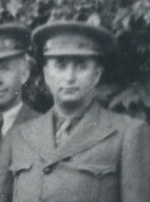More languages
More actions
No edit summary Tag: Visual edit |
No edit summary Tag: Visual edit: Switched |
||
| Line 16: | Line 16: | ||
== References == | == References == | ||
[[Category:1890 births]] | |||
[[Category:1939 deaths]] | |||
[[Category:Austro-Hungarian military personnel of World War I]] | [[Category:Austro-Hungarian military personnel of World War I]] | ||
[[Category:Hungarian anti-fascists]] | [[Category:Hungarian anti-fascists]] | ||
Revision as of 17:26, 8 June 2024
János Gálicz | |
|---|---|
 | |
| Native name | Gálicz János |
| Nickname(s) | General Gal |
| Born | 1890 Tótkomlós, Békés County, Hungary, Austria-Hungary) |
| Died | 1939 (aged 48–49) Moscow, Russian SFSR, Soviet Union |
| Allegiance | Austria-Hungary Hungarian Soviet Republic Soviet Union |
| Service/ | Red Army International Brigades |
| Rank | Polkovnik |
| Commands held | Abraham Lincoln Brigade 15th Division |
| Known for | his actions during the Spanish Civil War |
| Battles/wars | |
Gálicz János (1890 – 1939), also known as José Ivanovich Gal, General Gal, or General Gall, was a Hungarian-Soviet commander of the Spanish Civil War.
Gálicz served in the Austro-Hungarian Army during World War I. He was captured by the Russians, became a Marxist, was freed by the Bolsheviks, and fought in the Red Army during the Russian Civil War. He also participated in Béla Kun's Hungarian Soviet Republic, although he was forced into exile to Russia after the republic collapsed.[1]
Gal gained infamy for his actions as commander of the XV International Brigade. During the Battle of Jarama in 1937, he sent hundreds of his own men to their deaths in what Ernest Hemingway later described as an "idiotic, stupidly conceived and insanely executed attack"[2] on Pingarrón Hill, also known as "Suicide Hill",[3] throwing outnumbered and inexperienced troops at a heavily-fortified uphill enemy position, against the advice of his subordinates.[4] Hemingway wrote that "He [Gálicz] should have been shot at the time."[2]
Gálicz later served as the commander of the 15th Division.
Gálicz was removed from his position after the "deplorable" conditions in his sector became known, and in 1939, after he returned to the Soviet Union, he was tried by a people's court and sentenced to death by shooting.[2] The sentence was carried out on 20 October 1939.
References
- ↑ Eby, Cecil D. (2007).: Comrades and Commissars: The Lincoln Battalion in the Spanish Civil War. Penn State University Press. p. 65.
- ↑ 2.0 2.1 2.2 Regler, Gustav; Hemingway, Ernest; Chambers, Whittaker; Mussey, June Barrows (1940).: The Great Crusade. Longmans, Green & Co. New York. p. vii.
- ↑ Wintringham, Thomas Henry (1940).: Comrades of Jarama. Volunteer for Liberty. p. 4.
- ↑ Merriman, Marion (1986).: For Whom the Bell Tolled. The Washington Post.
